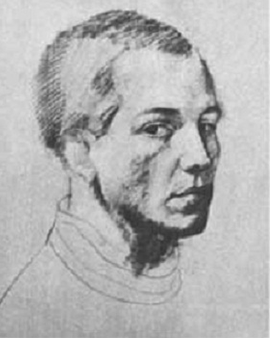


Ubaldo Oppi, an outstanding artist of the 20th century, was born on July 25, 1889 and played an important role in the founding of the "Novecento Italiano" in Milan. His impressive paintings, produced in the neo-realist style of the Quattrocento, were an expression of his deep appreciation for classical aesthetics and at the same time a bold step into a modern artistic era. Originally born in Bologna, his family moved to Vicenza when he was just four years old. His father, a shoe salesman, sent him to the far north to learn the shoe trade. But the artistic fire in Oppi led him instead to Vienna, where he studied between 1907 and 1909 under the guidance of the renowned artist Gustav Klimt.
After a brief military stint on the Adriatic coast, his art took him to Paris, where he moved in the circles of modern artists. There he established relationships with influential figures in the art world, including Fernande Olivier, the mistress of Pablo Picasso. The vibrant city was an ideal place for Oppi to hone his skills and sharpen his vision. The period of war turmoil made him return to the Italian army once again. During World War I, he participated in numerous battles, including the bloody Battle of Monte Pasubio. Being a prisoner of war in Mauthausen, a terrible experience, did not stop him from pursuing his passion for art. He returned to Paris in the 1920s and exhibited his work at the prestigious Salon des Indépendants and later at the Venice Biennale. He founded the "Novecento Italiano" together with other visionary artists such as Anselmo Bucci, Leonardo Dudreville, Achille Funi, Emilio Malerba, Pietro Marussig and Mario Sironi. This artistic awakening was promoted by Margherita Sarfatti and the emerging fascist party.
Oppi's path as an artist, however, was not subject to any preordained path. After only a few years, he left the "Novecento" group and exhibited his work independently at the 1926 Venice Biennale. His work gained international recognition and was exhibited in Monaco, Dresden, and Vienna, among other cities. In the late 1920s, Oppi took a spiritual turn. Many of his later works included religious motifs and altarpieces. He created impressive frescoes for the Chapel of San Francesco in the Basilica of St. Anthony in Padua and later for the church in Bolzano Vicentino.
During the Second World War he served as a lieutenant colonel of the Alpine troops. He died in Vicenza, but his artistic legacy remains alive. Today, Ubaldo Oppi art prints are more than just a tribute to a great artist - they are a window into an extraordinary era in Italian art history, allowing you to bring it right into your home or office.

Ubaldo Oppi, an outstanding artist of the 20th century, was born on July 25, 1889 and played an important role in the founding of the "Novecento Italiano" in Milan. His impressive paintings, produced in the neo-realist style of the Quattrocento, were an expression of his deep appreciation for classical aesthetics and at the same time a bold step into a modern artistic era. Originally born in Bologna, his family moved to Vicenza when he was just four years old. His father, a shoe salesman, sent him to the far north to learn the shoe trade. But the artistic fire in Oppi led him instead to Vienna, where he studied between 1907 and 1909 under the guidance of the renowned artist Gustav Klimt.
After a brief military stint on the Adriatic coast, his art took him to Paris, where he moved in the circles of modern artists. There he established relationships with influential figures in the art world, including Fernande Olivier, the mistress of Pablo Picasso. The vibrant city was an ideal place for Oppi to hone his skills and sharpen his vision. The period of war turmoil made him return to the Italian army once again. During World War I, he participated in numerous battles, including the bloody Battle of Monte Pasubio. Being a prisoner of war in Mauthausen, a terrible experience, did not stop him from pursuing his passion for art. He returned to Paris in the 1920s and exhibited his work at the prestigious Salon des Indépendants and later at the Venice Biennale. He founded the "Novecento Italiano" together with other visionary artists such as Anselmo Bucci, Leonardo Dudreville, Achille Funi, Emilio Malerba, Pietro Marussig and Mario Sironi. This artistic awakening was promoted by Margherita Sarfatti and the emerging fascist party.
Oppi's path as an artist, however, was not subject to any preordained path. After only a few years, he left the "Novecento" group and exhibited his work independently at the 1926 Venice Biennale. His work gained international recognition and was exhibited in Monaco, Dresden, and Vienna, among other cities. In the late 1920s, Oppi took a spiritual turn. Many of his later works included religious motifs and altarpieces. He created impressive frescoes for the Chapel of San Francesco in the Basilica of St. Anthony in Padua and later for the church in Bolzano Vicentino.
During the Second World War he served as a lieutenant colonel of the Alpine troops. He died in Vicenza, but his artistic legacy remains alive. Today, Ubaldo Oppi art prints are more than just a tribute to a great artist - they are a window into an extraordinary era in Italian art history, allowing you to bring it right into your home or office.
Page 1 / 1






